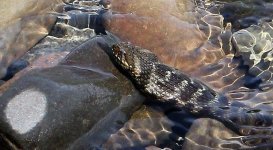I rarely use a binocular for things nearby, and when I do, I use a Pentax Papilio which lets me go as close as 50cm.
But I appreciate that some members here are using binoculars to observe insects and the like, and maybe they can give me an answer to my question:
If I am not mistaken, when observing with the EL 10x42 at a close focus of 1.5m I see the observed object as if it was only 1/10 of that distance away, i.e. at 15 cm. With the close focus of the EL changing to 3.3m, the apparent distance of the observed object is now 33 cm, i.e. 18 cm more than before.
How much detail recognition do I really lose if my insect is 18 cm further away?
Or what am I missing here?
Canip
Thank you for asking a good question. I can only answer for myself and don't claim to speak for others.
For me close focus isn't just about insects. I use binos to examine so many different things, here are some: yes butterflies and dragonflies are on my list as are bush crickets, moths and many others. But I also use them to observe snakes, lizards, newts, fish, crayfish, sea anemones, sea slugs, marine worms, and small mammals. Plus flowers especially those growing in bogs, on crags or on cliffs, as well as fungi and lichens.
For those subjects that might flee such as snakes, lizards, newts, fish and many insects, for much of the time the close focus is important because when you find yourself unexpectedly close to one of them, you don't want to have to step back to focus your binos on them because your movement may scare them off into the undergrowth. This happens so many times. We often move through habitats slowly and carefully, on the look out for something specific like otters in Scotland or dragonflies in France, and when easing your way around a bush or a rock you may find a Field Vole eating some grass or a snake eating a fish, very, very close (see pic below of the snake eating the fish) or a lizard basking in the sun (see second pic below, I hardly dared to move but I got the pic and it looked fabulous through the binos). At this point, there is usually a moment or two when the animal or whatever either flees or stays still, trusting in lack of movement to escape being seen. Getting a close look at stuff through binos at this moment is a fantastic experience and is almost always ruined if you need to step back to use your binos because they don't focus close enough. Your movement scares the animal away.
You ask if it makes much difference whether you lose some detail if you are 18cm further away. As explained above, the distance isn't always your choice and if you need to move to focus the result is no detail at all because the subject flees. But as with birds, the detail you need to identify some subjects can vary. Some butterflies need examination of their markings and some dragonflies might need examination of the wing venation or other clues. And much depends on the size of the insect, some dragonflies are large while some damselflies are very small indeed.
And discussing the difference between a close focus of 1.5m and 3.3m is a bit like discussing why people like 10x magnification vs 8x. The bigger the image, the more pleasurable the experience.
Birds are fascinating and are what got me interested in nature in the first place and to go birding 3.3m close focus is adequate, but if you have any interest in the other 90% of nature and want to make the most of every observing opportunity that nature puts in front of your binos (and the ones we have been talking about are very very expensive) then I for one want those binos to be as versatile as possible and a 3.3m close focus would have made impossible hundreds of wonderful wildlife observations that I have been privileged to have experienced.
Many binos focus as close as 2.0m or even closer today, 1,5m is common and some like Leica's Trinovid HD 8x32 focus to around 1.0m. Bino brands are not doing this because close focus is unimportant in the market, and Swarovski isn't making sure their best close focus is only available on their top, most expensive model because it makes no difference which model has this capability.
BTW take a look at the snake and you can see the tail fins of the fish it is eating sticking out of its mouth. The snake 'froze' when I appeared very close by and by good fortune I already had my camera out and was able to grab a couple of shots. The view through the binos was impressive. Then the snake slowly eased itself back underwater and swam off.
Lee







